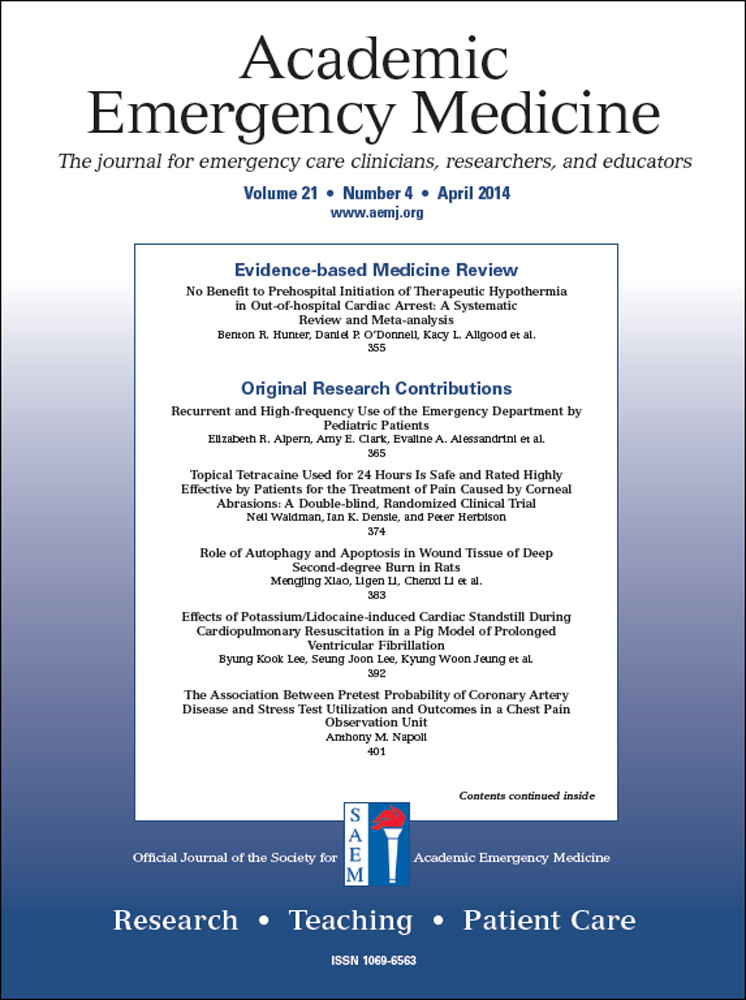Geriatric Syndromes Predict Postdischarge Outcomes Among Older Emergency Department Patients: Findings From the interRAI Multinational Emergency Department Study
Los Síndromes Geriátricos Predicen los Resultados Tras el Alta en los Pacientes Mayores del Servicio de Urgencias: Resultados del InterRAI Multinational Emergency Department Study
Abstract
enObjectives
Identifying older emergency department (ED) patients with clinical features associated with adverse postdischarge outcomes may lead to improved clinical reasoning and better targeting for preventative interventions. Previous studies have used single-country samples to identify limited sets of determinants for a limited number of proxy outcomes. The objective of this study was to identify and compare geriatric syndromes that influence the probability of postdischarge outcomes among older ED patients from a multinational context.
Methods
A multinational prospective cohort study of ED patients aged 75 years or older was conducted. A total of 13 ED sites from Australia, Belgium, Canada, Germany, Iceland, India, and Sweden participated. Patients who were expected to die within 24 hours or did not speak the native language were excluded. Of the 2,475 patients approached for inclusion, 2,282 (92.2%) were enrolled. Patients were assessed at ED admission with the interRAI ED Contact Assessment, a geriatric ED assessment. Outcomes were examined for patients admitted to a hospital ward (62.9%, n = 1,436) or discharged to a community setting (34.0%, n = 775) after an ED visit. Overall, 3% of patients were lost to follow-up. Hospital length of stay (LOS) and discharge to higher level of care was recorded for patients admitted to a hospital ward. Any ED or hospital use within 28 days of discharge was recorded for patients discharged to a community setting. Unadjusted and adjusted odds ratios (ORs) were used to describe determinants using standard and multilevel logistic regression.
Results
A multi-country model including living alone (OR = 1.78, p ≤ 0.01), informal caregiver distress (OR = 1.69, p = 0.02), deficits in ambulation (OR = 1.94, p ≤ 0.01), poor self-report (OR = 1.84, p ≤ 0.01), and traumatic injury (OR = 2.18, p ≤ 0.01) best described older patients at risk of longer hospital lengths of stay. A model including recent ED visits (OR = 2.10, p ≤ 0.01), baseline functional impairment (OR = 1.68, p ≤ 0.01), and anhedonia (OR = 1.73, p ≤ 0.01) best described older patients at risk of proximate repeat hospital use. A sufficiently accurate and generalizable model to describe the risk of discharge to higher levels of care among admitted patients was not achieved.
Conclusions
Despite markedly different health care systems, the probability of long hospital lengths of stay and repeat hospital use among older ED patients is detectable at the multinational level with moderate accuracy. This study demonstrates the potential utility of incorporating common geriatric clinical features in routine clinical examination and disposition planning for older patients in EDs.
Resumen
esObjetivos
La identificación de los pacientes mayores del servicio de urgencias (SU) con hallazgos clínicos asociados con resultados adversos tras el alta puede conducir a mejorar el juicio clínico y a establecer mejores objetivos para las intervenciones preventivas. Estudios previos han utilizado muestras de un solo país para identificar conjuntos limitados de determinantes para un número limitado de resultados en la toma de decisiones. El objetivo de este estudio fue identificar y comparar los síndromes geriátricos que influyen en la probabilidad de los resultados tras el alta en los pacientes mayores del SU desde un contexto multinacional.
Metodología
Estudio de cohorte prospectivo multinacional que se llevó a cabo en pacientes del SU de 75 años o más. Participaron un total de 13 SU de Australia, Bélgica, Canadá, Alemania, Islandia, India y Suecia. Se excluyeron los pacientes que se esperaba fallecieran en las primeras 24 horas o aquéllos de habla no nativa. De los 2.475 pacientes valorados para la inclusión, se incluyeron 2.282 (92,2%). Los pacientes se valoraron al ingreso del SU mediante la interRAI ED Contact Assessment, una valoración geriátrica en el SU. Los resultados se evaluaron para los pacientes ingresados en un planta del hospital (62,9%, n = 1.436) o dados de alta a la comunidad (34,0%, n = 775) tras una visita al SU. Del total, en un 3% de los pacientes se perdió el seguimiento. La estancia hospitalaria y el alta a un nivel de atención mayor se documentaron para los pacientes ingresados en una planta del hospital. Cualquier uso del hospital o del SU en los primeros 28 días tras el alta se documentó en los pacientes dados de alta a la comunidad. La razón de ventajas (odds ratio, OR) ajustada y no ajustada se usó para describir los determinantes usando una regresión logística convencional y multinivel.
Resultados
Un modelo multinacional que incluye el vivir solo (OR = 1,78, p ≤ 0,01), el estrés del cuidador (OR = 1,69, p = 0,02), el deterioro en la deambulación (OR = 1,94, p ≤ 0,01), el documentar baja autoestima (OR = 1,84, p ≤ 0,01), y la lesión traumatológica (OR = 2,18, p ≤ 0,01) es el que mejor describió a los pacientes mayores con riesgo de estancias hospitalarias más prolongadas. Un modelo que incluye las visitas recientes al SU (OR = 2,10, p ≤ 0,01), el deterioro funcional basal (OR = 1,68, p ≤ 0,01) y la incapacidad para experimentar placer (OR = 1,73, p ≤ 0,01) es el que mejor describió a los pacientes mayores con riesgo incrementado de repetir el uso hospitalario a corto plazo. No se alcanzó un modelo suficientemente preciso ni generalizable para describir el riesgo al alta de necesitar niveles mayores de atención en los pacientes ingresados.
Conclusiones
A pesar de la diferencia marcada de los sistemas sanitarios, la probabilidad de estancia prolongada en el hospital y uso repetido del hospital entre los pacientes mayores del SU es detectable desde una perspectiva multinacional con una precisión moderada. Este estudio demuestra la potencial utilidad de incorporar los hallazgos clínicos geriátricos comunes en la valoración clínica rutinaria y en la planificación de la ubicación de los pacientes mayores en el SU.




